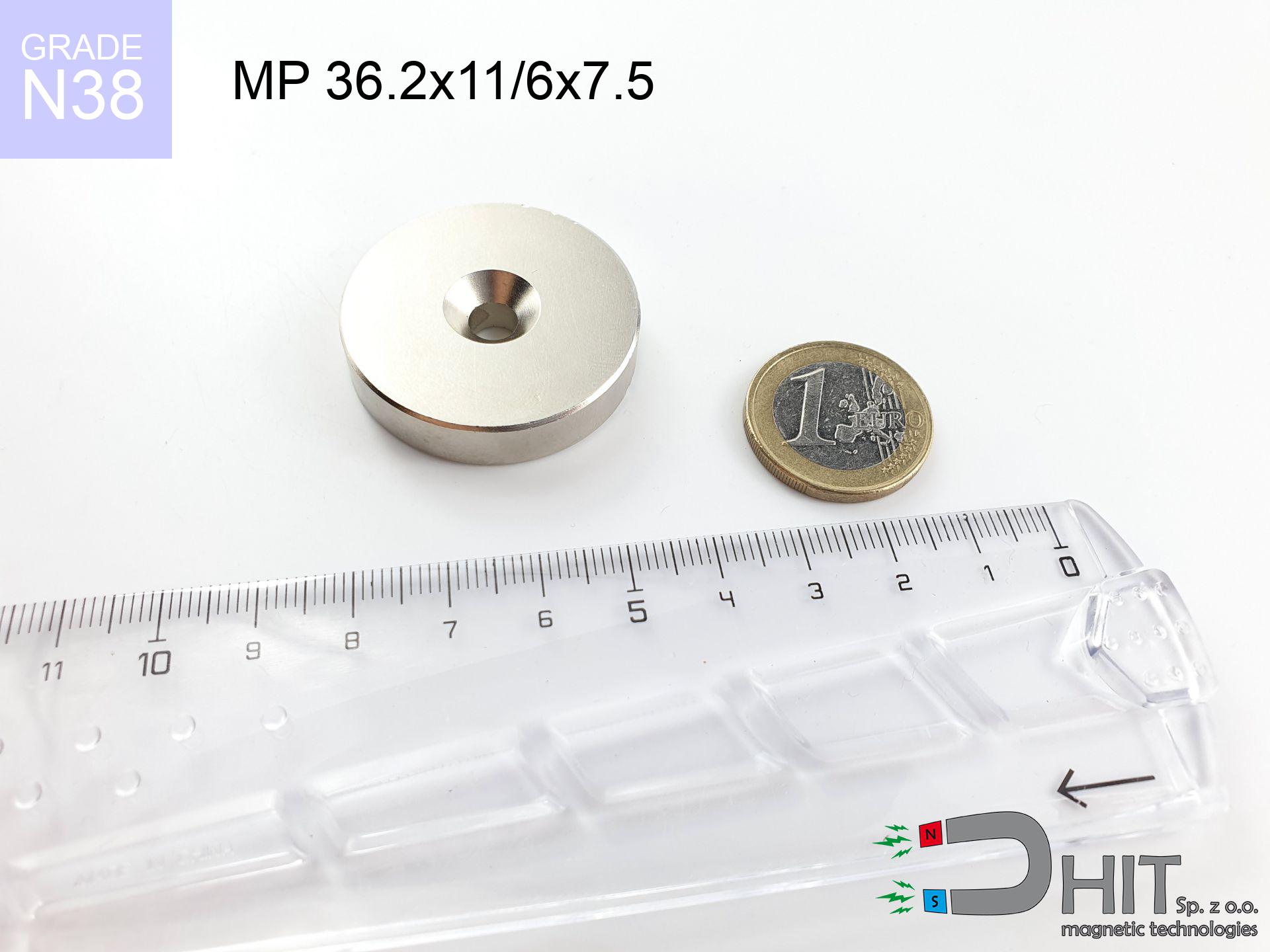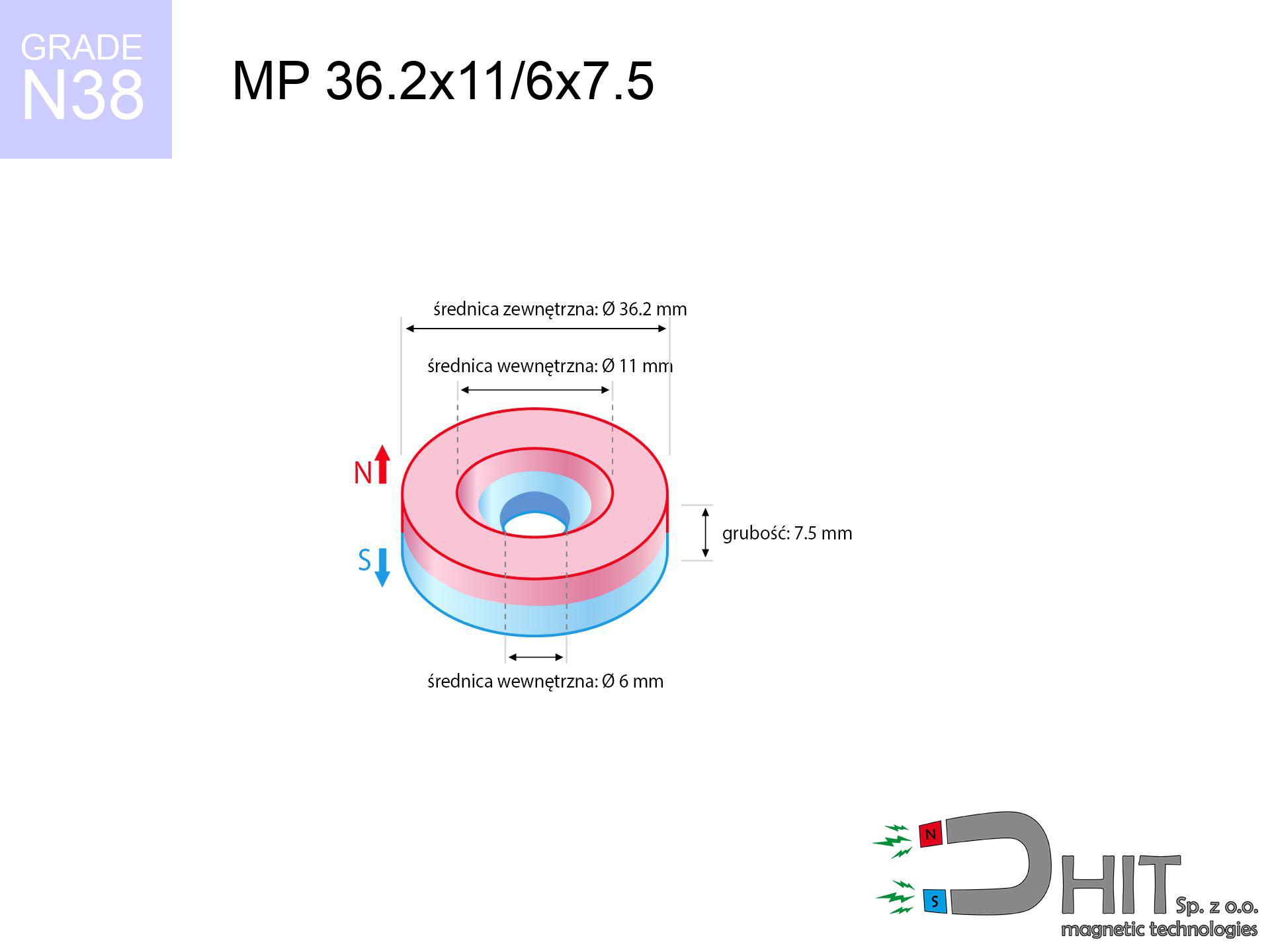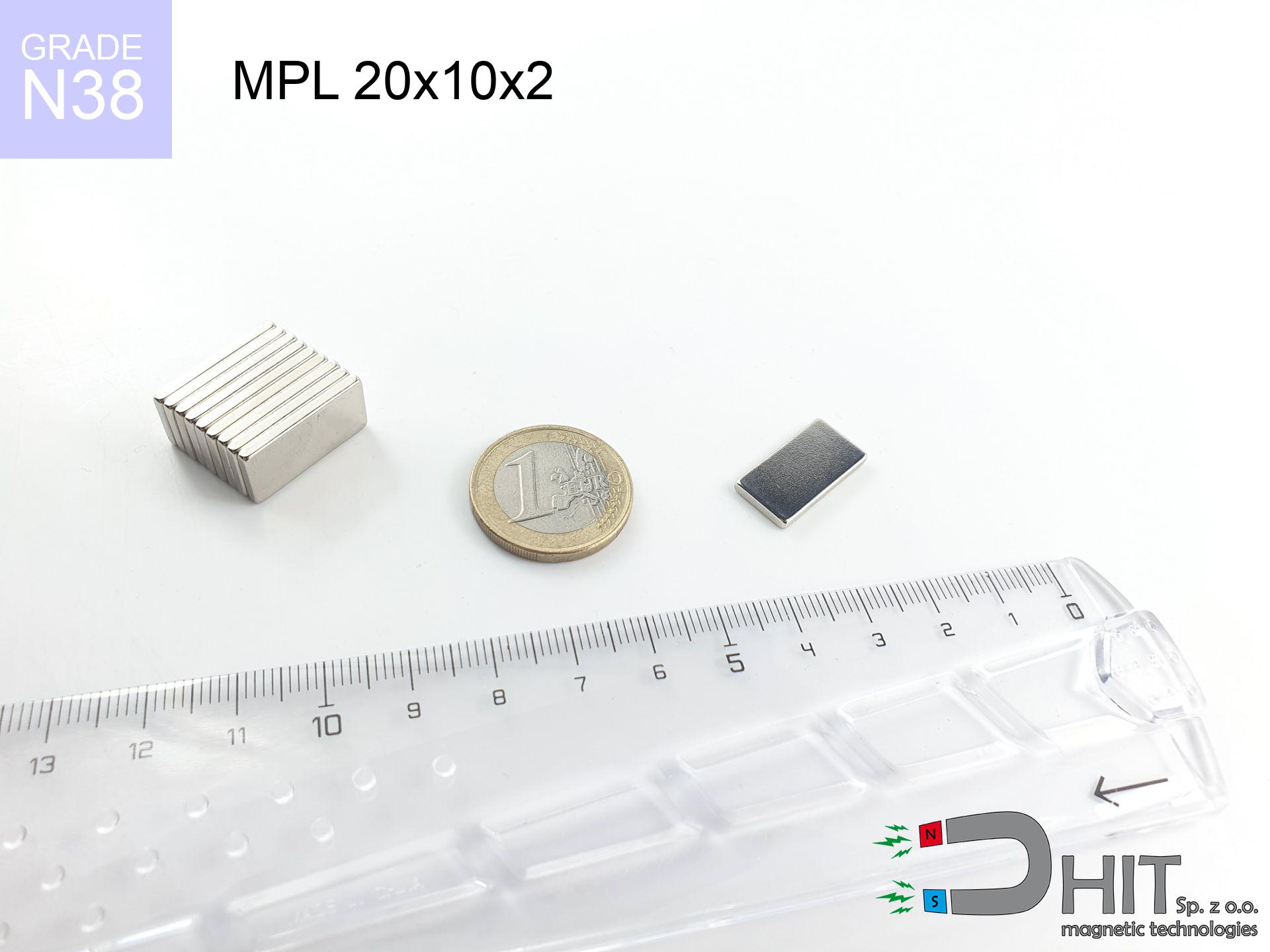MP 36.2x11/6x7.5 / N38 - ring magnet
ring magnet
Catalog no 030248
GTIN/EAN: 5906301812241
Diameter
36.2 mm [±0,1 mm]
internal diameter Ø
11/6 mm [±0,1 mm]
Height
7.5 mm [±0,1 mm]
Weight
56.3 g
Magnetization Direction
↑ axial
Load capacity
17.12 kg / 167.95 N
Magnetic Induction
237.29 mT / 2373 Gs
Coating
[NiCuNi] Nickel
35.01 ZŁ with VAT / pcs + price for transport
28.46 ZŁ net + 23% VAT / pcs
bulk discounts:
Need more?Not sure where to buy?
Contact us by phone
+48 22 499 98 98
or let us know by means of
contact form
through our site.
Strength and shape of a magnet can be analyzed using our
our magnetic calculator.
Orders submitted before 14:00 will be dispatched today!
MP 36.2x11/6x7.5 / N38 - ring magnet
Specification / characteristics MP 36.2x11/6x7.5 / N38 - ring magnet
| properties | values |
|---|---|
| Cat. no. | 030248 |
| GTIN/EAN | 5906301812241 |
| Production/Distribution | Dhit sp. z o.o. |
| Country of origin | Poland / China / Germany |
| Customs code | 85059029 |
| Diameter | 36.2 mm [±0,1 mm] |
| internal diameter Ø | 11/6 mm [±0,1 mm] |
| Height | 7.5 mm [±0,1 mm] |
| Weight | 56.3 g |
| Magnetization Direction | ↑ axial |
| Load capacity ~ ? | 17.12 kg / 167.95 N |
| Magnetic Induction ~ ? | 237.29 mT / 2373 Gs |
| Coating | [NiCuNi] Nickel |
| Manufacturing Tolerance | ±0.1 mm |
Magnetic properties of material N38
| properties | values | units |
|---|---|---|
| remenance Br [min. - max.] ? | 12.2-12.6 | kGs |
| remenance Br [min. - max.] ? | 1220-1260 | mT |
| coercivity bHc ? | 10.8-11.5 | kOe |
| coercivity bHc ? | 860-915 | kA/m |
| actual internal force iHc | ≥ 12 | kOe |
| actual internal force iHc | ≥ 955 | kA/m |
| energy density [min. - max.] ? | 36-38 | BH max MGOe |
| energy density [min. - max.] ? | 287-303 | BH max KJ/m |
| max. temperature ? | ≤ 80 | °C |
Physical properties of sintered neodymium magnets Nd2Fe14B at 20°C
| properties | values | units |
|---|---|---|
| Vickers hardness | ≥550 | Hv |
| Density | ≥7.4 | g/cm3 |
| Curie Temperature TC | 312 - 380 | °C |
| Curie Temperature TF | 593 - 716 | °F |
| Specific resistance | 150 | μΩ⋅cm |
| Bending strength | 250 | MPa |
| Compressive strength | 1000~1100 | MPa |
| Thermal expansion parallel (∥) to orientation (M) | (3-4) x 10-6 | °C-1 |
| Thermal expansion perpendicular (⊥) to orientation (M) | -(1-3) x 10-6 | °C-1 |
| Young's modulus | 1.7 x 104 | kg/mm² |
Technical simulation of the magnet - technical parameters
Presented information are the result of a physical simulation. Results rely on algorithms for the class Nd2Fe14B. Operational conditions might slightly deviate from the simulation results. Use these calculations as a reference point when designing systems.
MP 36.2x11/6x7.5 / N38
| Distance (mm) | Induction (Gauss) / mT | Pull Force (kg) | Risk Status |
|---|---|---|---|
| 0 mm |
2059 Gs
205.9 mT
|
17.12 kg / 17120.0 g
167.9 N
|
dangerous! |
| 1 mm |
1997 Gs
199.7 mT
|
16.11 kg / 16110.1 g
158.0 N
|
dangerous! |
| 2 mm |
1923 Gs
192.3 mT
|
14.93 kg / 14925.7 g
146.4 N
|
dangerous! |
| 3 mm |
1838 Gs
183.8 mT
|
13.64 kg / 13636.4 g
133.8 N
|
dangerous! |
| 5 mm |
1648 Gs
164.8 mT
|
10.97 kg / 10968.0 g
107.6 N
|
dangerous! |
| 10 mm |
1161 Gs
116.1 mT
|
5.44 kg / 5444.8 g
53.4 N
|
warning |
| 15 mm |
775 Gs
77.5 mT
|
2.43 kg / 2427.5 g
23.8 N
|
warning |
| 20 mm |
515 Gs
51.5 mT
|
1.07 kg / 1071.1 g
10.5 N
|
safe |
| 30 mm |
242 Gs
24.2 mT
|
0.24 kg / 236.8 g
2.3 N
|
safe |
| 50 mm |
73 Gs
7.3 mT
|
0.02 kg / 21.8 g
0.2 N
|
safe |
MP 36.2x11/6x7.5 / N38
| Distance (mm) | Friction coefficient | Pull Force (kg) |
|---|---|---|
| 0 mm | Stal (~0.2) |
3.42 kg / 3424.0 g
33.6 N
|
| 1 mm | Stal (~0.2) |
3.22 kg / 3222.0 g
31.6 N
|
| 2 mm | Stal (~0.2) |
2.99 kg / 2986.0 g
29.3 N
|
| 3 mm | Stal (~0.2) |
2.73 kg / 2728.0 g
26.8 N
|
| 5 mm | Stal (~0.2) |
2.19 kg / 2194.0 g
21.5 N
|
| 10 mm | Stal (~0.2) |
1.09 kg / 1088.0 g
10.7 N
|
| 15 mm | Stal (~0.2) |
0.49 kg / 486.0 g
4.8 N
|
| 20 mm | Stal (~0.2) |
0.21 kg / 214.0 g
2.1 N
|
| 30 mm | Stal (~0.2) |
0.05 kg / 48.0 g
0.5 N
|
| 50 mm | Stal (~0.2) |
0.00 kg / 4.0 g
0.0 N
|
MP 36.2x11/6x7.5 / N38
| Surface type | Friction coefficient / % Mocy | Max load (kg) |
|---|---|---|
| Raw steel |
µ = 0.3
30% Nominalnej Siły
|
5.14 kg / 5136.0 g
50.4 N
|
| Painted steel (standard) |
µ = 0.2
20% Nominalnej Siły
|
3.42 kg / 3424.0 g
33.6 N
|
| Oily/slippery steel |
µ = 0.1
10% Nominalnej Siły
|
1.71 kg / 1712.0 g
16.8 N
|
| Magnet with anti-slip rubber |
µ = 0.5
50% Nominalnej Siły
|
8.56 kg / 8560.0 g
84.0 N
|
MP 36.2x11/6x7.5 / N38
| Steel thickness (mm) | % power | Real pull force (kg) |
|---|---|---|
| 0.5 mm |
|
0.86 kg / 856.0 g
8.4 N
|
| 1 mm |
|
2.14 kg / 2140.0 g
21.0 N
|
| 2 mm |
|
4.28 kg / 4280.0 g
42.0 N
|
| 5 mm |
|
10.70 kg / 10700.0 g
105.0 N
|
| 10 mm |
|
17.12 kg / 17120.0 g
167.9 N
|
MP 36.2x11/6x7.5 / N38
| Ambient temp. (°C) | Power loss | Remaining pull | Status |
|---|---|---|---|
| 20 °C | 0.0% |
17.12 kg / 17120.0 g
167.9 N
|
OK |
| 40 °C | -2.2% |
16.74 kg / 16743.4 g
164.3 N
|
OK |
| 60 °C | -4.4% |
16.37 kg / 16366.7 g
160.6 N
|
|
| 80 °C | -6.6% |
15.99 kg / 15990.1 g
156.9 N
|
|
| 100 °C | -28.8% |
12.19 kg / 12189.4 g
119.6 N
|
MP 36.2x11/6x7.5 / N38
| Gap (mm) | Attraction (kg) (N-S) | Repulsion (kg) (N-N) |
|---|---|---|
| 0 mm |
22.24 kg / 22240 g
218.2 N
3 569 Gs
|
N/A |
| 1 mm |
21.62 kg / 21621 g
212.1 N
4 061 Gs
|
19.46 kg / 19459 g
190.9 N
~0 Gs
|
| 2 mm |
20.93 kg / 20928 g
205.3 N
3 995 Gs
|
18.84 kg / 18835 g
184.8 N
~0 Gs
|
| 3 mm |
20.18 kg / 20180 g
198.0 N
3 923 Gs
|
18.16 kg / 18162 g
178.2 N
~0 Gs
|
| 5 mm |
18.56 kg / 18564 g
182.1 N
3 763 Gs
|
16.71 kg / 16708 g
163.9 N
~0 Gs
|
| 10 mm |
14.25 kg / 14248 g
139.8 N
3 296 Gs
|
12.82 kg / 12823 g
125.8 N
~0 Gs
|
| 20 mm |
7.07 kg / 7073 g
69.4 N
2 322 Gs
|
6.37 kg / 6366 g
62.4 N
~0 Gs
|
| 50 mm |
0.64 kg / 637 g
6.2 N
697 Gs
|
0.57 kg / 573 g
5.6 N
~0 Gs
|
MP 36.2x11/6x7.5 / N38
| Object / Device | Limit (Gauss) / mT | Safe distance |
|---|---|---|
| Pacemaker | 5 Gs (0.5 mT) | 13.5 cm |
| Hearing aid | 10 Gs (1.0 mT) | 10.5 cm |
| Mechanical watch | 20 Gs (2.0 mT) | 8.5 cm |
| Mobile device | 40 Gs (4.0 mT) | 6.5 cm |
| Car key | 50 Gs (5.0 mT) | 6.0 cm |
| Payment card | 400 Gs (40.0 mT) | 2.5 cm |
| HDD hard drive | 600 Gs (60.0 mT) | 2.0 cm |
MP 36.2x11/6x7.5 / N38
| Start from (mm) | Speed (km/h) | Energy (J) | Predicted outcome |
|---|---|---|---|
| 10 mm |
20.79 km/h
(5.78 m/s)
|
0.94 J | |
| 30 mm |
30.72 km/h
(8.53 m/s)
|
2.05 J | |
| 50 mm |
39.36 km/h
(10.93 m/s)
|
3.36 J | |
| 100 mm |
55.61 km/h
(15.45 m/s)
|
6.72 J |
MP 36.2x11/6x7.5 / N38
| Technical parameter | Value / Description |
|---|---|
| Coating type | [NiCuNi] Nickel |
| Layer structure | Nickel - Copper - Nickel |
| Layer thickness | 10-20 µm |
| Salt spray test (SST) ? | 24 h |
| Recommended environment | Indoors only (dry) |
MP 36.2x11/6x7.5 / N38
| Parameter | Value | SI Unit / Description |
|---|---|---|
| Magnetic Flux | 21 038 Mx | 210.4 µWb |
| Pc Coefficient | 0.26 | Low (Flat) |
MP 36.2x11/6x7.5 / N38
| Environment | Effective steel pull | Effect |
|---|---|---|
| Air (land) | 17.12 kg | Standard |
| Water (riverbed) |
19.60 kg
(+2.48 kg Buoyancy gain)
|
+14.5% |
1. Shear force
*Note: On a vertical surface, the magnet holds merely ~20% of its perpendicular strength.
2. Steel thickness impact
*Thin metal sheet (e.g. 0.5mm PC case) drastically reduces the holding force.
3. Power loss vs temp
*For N38 material, the critical limit is 80°C.
4. Demagnetization curve and operating point (B-H)
chart generated for the permeance coefficient Pc (Permeance Coefficient) = 0.26
This simulation demonstrates the magnetic stability of the selected magnet under specific geometric conditions. The solid red line represents the demagnetization curve (material potential), while the dashed blue line is the load line based on the magnet's geometry. The Pc (Permeance Coefficient), also known as the load line slope, is a dimensionless value that describes the relationship between the magnet's shape and its magnetic stability. The intersection of these two lines (the black dot) is the operating point — it determines the actual magnetic flux density generated by the magnet in this specific configuration. A higher Pc value means the magnet is more 'slender' (tall relative to its area), resulting in a higher operating point and better resistance to irreversible demagnetization caused by external fields or temperature. A value of 0.42 is relatively low (typical for flat magnets), meaning the operating point is closer to the 'knee' of the curve — caution is advised when operating at temperatures near the maximum limit to avoid strength loss.
Chemical composition
| iron (Fe) | 64% – 68% |
| neodymium (Nd) | 29% – 32% |
| boron (B) | 1.1% – 1.2% |
| dysprosium (Dy) | 0.5% – 2.0% |
| coating (Ni-Cu-Ni) | < 0.05% |
Environmental data
| recyclability (EoL) | 100% |
| recycled raw materials | ~10% (pre-cons) |
| carbon footprint | low / zredukowany |
| waste code (EWC) | 16 02 16 |
View more proposals
Pros as well as cons of rare earth magnets.
Advantages
- Their magnetic field remains stable, and after approximately ten years it drops only by ~1% (according to research),
- Magnets perfectly resist against loss of magnetization caused by foreign field sources,
- By applying a lustrous layer of silver, the element presents an nice look,
- Magnetic induction on the working part of the magnet turns out to be extremely intense,
- Made from properly selected components, these magnets show impressive resistance to high heat, enabling them to function (depending on their shape) at temperatures up to 230°C and above...
- Possibility of individual modeling as well as optimizing to complex requirements,
- Wide application in modern industrial fields – they are used in computer drives, motor assemblies, medical devices, and multitasking production systems.
- Compactness – despite small sizes they generate large force, making them ideal for precision applications
Cons
- To avoid cracks under impact, we recommend using special steel housings. Such a solution protects the magnet and simultaneously improves its durability.
- We warn that neodymium magnets can reduce their power at high temperatures. To prevent this, we suggest our specialized [AH] magnets, which work effectively even at 230°C.
- When exposed to humidity, magnets start to rust. For applications outside, it is recommended to use protective magnets, such as those in rubber or plastics, which prevent oxidation and corrosion.
- Limited possibility of creating threads in the magnet and complex shapes - recommended is cover - mounting mechanism.
- Potential hazard related to microscopic parts of magnets are risky, if swallowed, which is particularly important in the context of child health protection. Additionally, small elements of these magnets can be problematic in diagnostics medical after entering the body.
- Higher cost of purchase is one of the disadvantages compared to ceramic magnets, especially in budget applications
Lifting parameters
Maximum lifting capacity of the magnet – what contributes to it?
- on a base made of mild steel, effectively closing the magnetic flux
- with a thickness no less than 10 mm
- with a plane free of scratches
- under conditions of ideal adhesion (metal-to-metal)
- for force applied at a right angle (in the magnet axis)
- at ambient temperature approx. 20 degrees Celsius
What influences lifting capacity in practice
- Air gap (betwixt the magnet and the plate), as even a tiny distance (e.g. 0.5 mm) leads to a reduction in force by up to 50% (this also applies to varnish, rust or dirt).
- Direction of force – maximum parameter is reached only during perpendicular pulling. The force required to slide of the magnet along the plate is usually several times lower (approx. 1/5 of the lifting capacity).
- Wall thickness – the thinner the sheet, the weaker the hold. Magnetic flux penetrates through instead of generating force.
- Metal type – not every steel attracts identically. High carbon content weaken the interaction with the magnet.
- Surface quality – the more even the plate, the better the adhesion and higher the lifting capacity. Unevenness acts like micro-gaps.
- Temperature influence – high temperature weakens magnetic field. Too high temperature can permanently demagnetize the magnet.
Holding force was checked on the plate surface of 20 mm thickness, when the force acted perpendicularly, whereas under shearing force the load capacity is reduced by as much as 75%. Additionally, even a slight gap between the magnet and the plate reduces the lifting capacity.
Power loss in heat
Keep cool. NdFeB magnets are susceptible to heat. If you need operation above 80°C, ask us about HT versions (H, SH, UH).
Safe distance
Device Safety: Strong magnets can ruin data carriers and delicate electronics (pacemakers, hearing aids, timepieces).
Flammability
Drilling and cutting of neodymium magnets poses a fire hazard. Magnetic powder reacts violently with oxygen and is difficult to extinguish.
Phone sensors
Be aware: rare earth magnets generate a field that interferes with sensitive sensors. Maintain a safe distance from your phone, tablet, and navigation systems.
Pacemakers
People with a heart stimulator have to keep an large gap from magnets. The magnetic field can disrupt the operation of the life-saving device.
Do not underestimate power
Before use, read the rules. Sudden snapping can break the magnet or hurt your hand. Be predictive.
No play value
Adult use only. Small elements can be swallowed, causing intestinal necrosis. Store out of reach of children and animals.
Nickel allergy
Medical facts indicate that the nickel plating (the usual finish) is a strong allergen. For allergy sufferers, avoid touching magnets with bare hands and opt for coated magnets.
Risk of cracking
Despite the nickel coating, the material is delicate and not impact-resistant. Do not hit, as the magnet may crumble into sharp, dangerous pieces.
Crushing force
Danger of trauma: The pulling power is so great that it can cause hematomas, crushing, and even bone fractures. Protective gloves are recommended.




![UMGGZ 66x8.5 [M8] GZ / N38 - rubber magnetic holder external thread UMGGZ 66x8.5 [M8] GZ / N38 - rubber magnetic holder external thread](https://cdn3.dhit.pl/graphics/products/umggz-66x8.5-m6-gz-gas.jpg)




